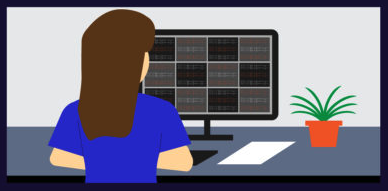Video EEG Monitoring
With the advent of the new CPT® code set covering video EEG monitoring (VEEG), we have gone from roughly five broad codes covering the procedure to 23 codes with very specific requirements. My focus here is on the concept of monitoring.
What is it?
In my early days as a fellow and young attending, all video EEG studies were done in the hospital and EEGs were still recorded on paper, for the most part. They had to be – the cameras were large and fixed, and physical cables were needed to carry the EEG and video data to the control room. At our institution, a technologist was on duty 24/7 to continuously monitor the patient’s EEG and clinical status. Early ambulatory studies were very different – the equipment was sent home with the patient and the EEG was recorded on cassette tapes. There was no video or monitoring. The patient would return after several days and the tapes would be converted to paper EEG (though many of the epilepsy docs would simply listen to the cassette on a regular player because they could hear if a seizure occurred). Study quality for the inpatient studies was generally very good with the added benefits of concurrent video. Study quality for the ambulatory studies was generally poor, with little in the way of usable data after the first 12-24 hours. This was primarily due to electrode displacement causing signal loss.
With the advent of the internet and improvement in speed, better and smaller cameras, and faster and more powerful computers, recording capabilities have completely changed. Regardless of patient location, video-EEG monitoring is increasingly done wirelessly. An EEG technologist continuously monitoring an inpatient with a dozen implanted stereo-EEG electrodes may be located blocks or even miles away. Video is also increasingly recorded for even routine EEG studies. If the technical capabilities have advanced to the point where the equipment is nearly identical for the inpatient and outpatient setting, what about the monitoring?
What type of monitoring is important?
The technical codes for intermittent monitoring require the EEG technologist(s) to monitor and document real-time review of data at least every two hours during the entire recording session. The responsibilities include ensuring the integrity and quality of the recording (performing maintenance, troubleshooting technical issues, reattaching electrodes when needed), communicating with the patient or caregiver, and notifying the physician or qualified health professional of clinical issues. The essential part of intermittent monitoring is the preservation of the EEG and video data stream. This ensures that a 72-hour study will have close to 72 hours of usable data.
The technical codes for continuous monitoring require the EEG technologist(s) to monitor and document real-time, concurrent, and continuous monitoring during the entire recording period. The responsibilities are essentially identical to those described for intermittent monitoring. But the reality is that continuous monitoring is necessary for situations where much closer attention must be paid to the patient. The patient is either unstable enough that any significant clinical change will require some form of immediate medical intervention or the patient is undergoing a pre-surgical workup for possible resective surgery to remediate their epilepsy. The latter situation commonly involves reducing anti-seizure medications (creating the risk of status epilepticus) and the requirement that staff interacts directly with the patient during a seizure.
In short, any patient whose circumstances mandate continuous monitoring needs to be studied inside of a hospital. On the flip side, patients who are simply undergoing a diagnostic evaluation to determine the etiology of their events, who are not undergoing a pre-surgical workup and who are not having reductions made to their anti-seizure medications, do not need continuous monitoring – intermittent is more than sufficient. In that light, intermittent monitoring is appropriate for the vast majority of in-home ambulatory video EEG studies.
The seizure risk for any patient undergoing a study in their home is exactly the same as it was the night before when they were not being monitored, and the night after monitoring has been completed. If they are sick enough to warrant continuous monitoring, they need to be in the hospital. If they are not, intermittent monitoring provides the best value to the physician, patient, and payor.
About the Author

Jeremy Slater, M.D., has worked in the field of epilepsy for more than 27 years and currently serves as the Chief Medical Officer for Stratus. He served as the director of the Texas Comprehensive Epilepsy Program from 2004 through 2017, growing the center from a single neurologist and neurosurgeon to one of the largest epilepsy surgery programs in the country. Dr. Slater earned his medical degree at the University of Pittsburgh School of Medicine, in Pittsburgh, PA. He completed his residency in neurology followed by a fellowship in epilepsy and clinical neurophysiology at the University of Miami School of Medicine in Miami, FL.



